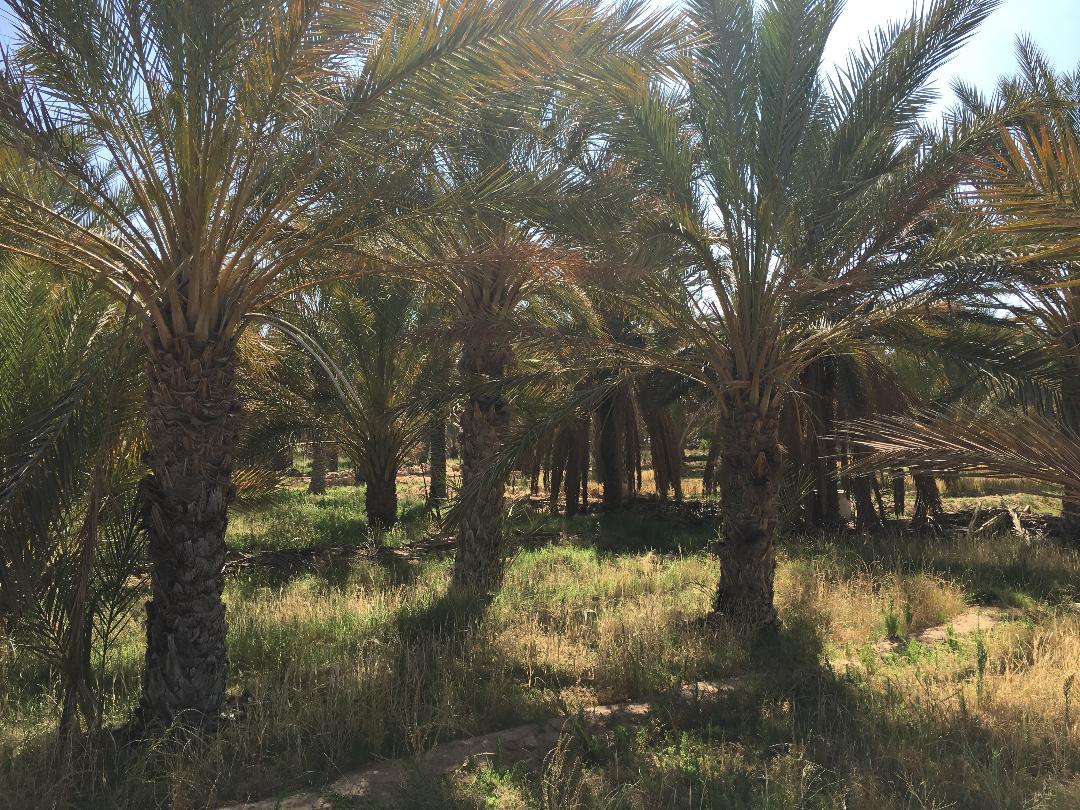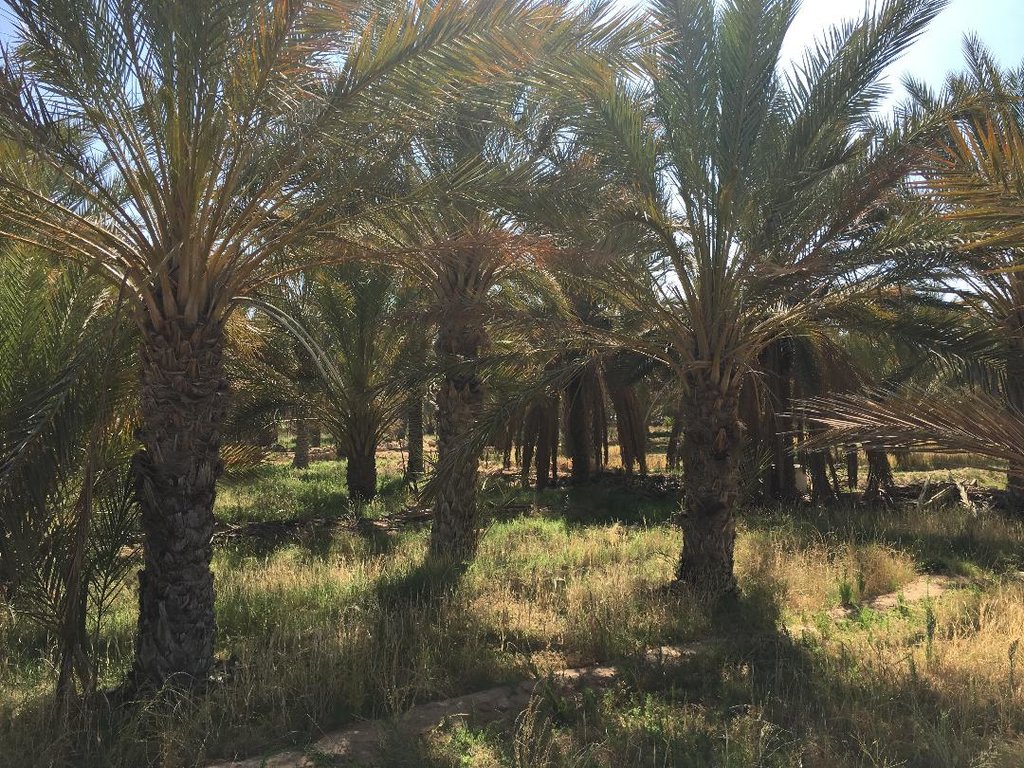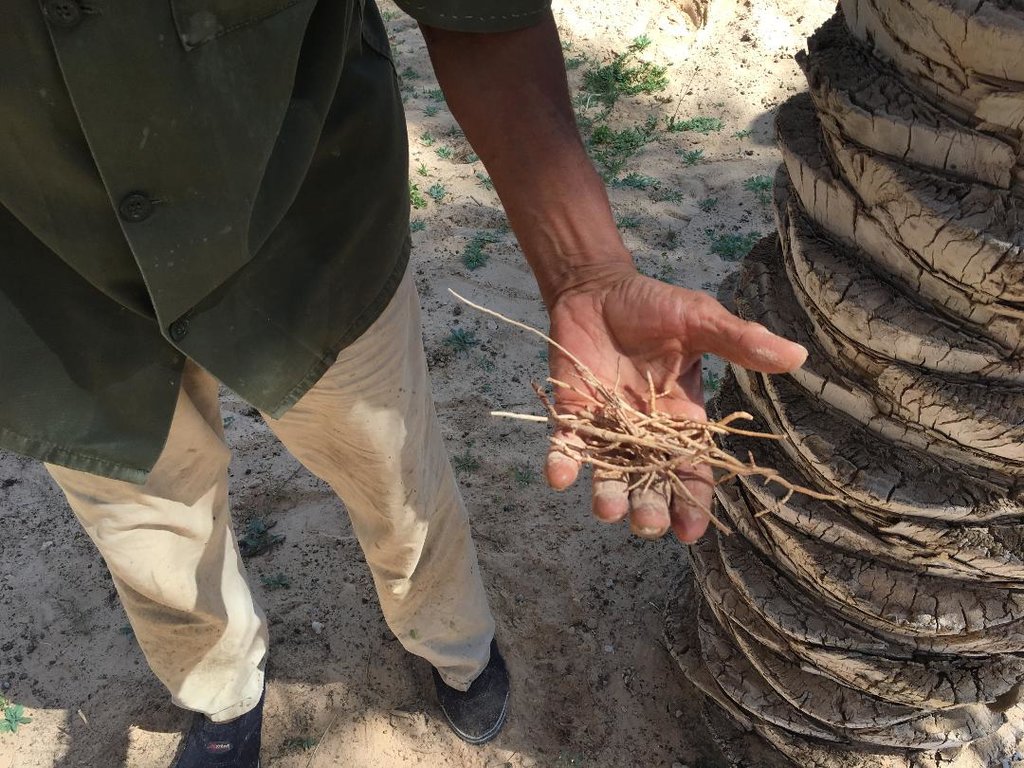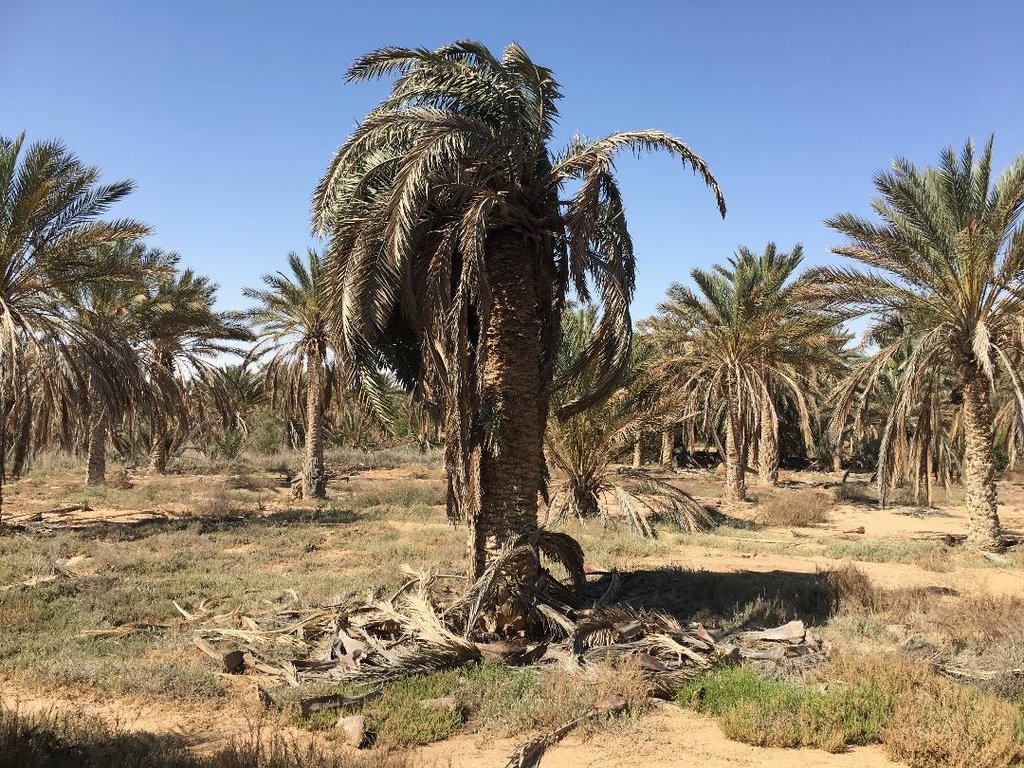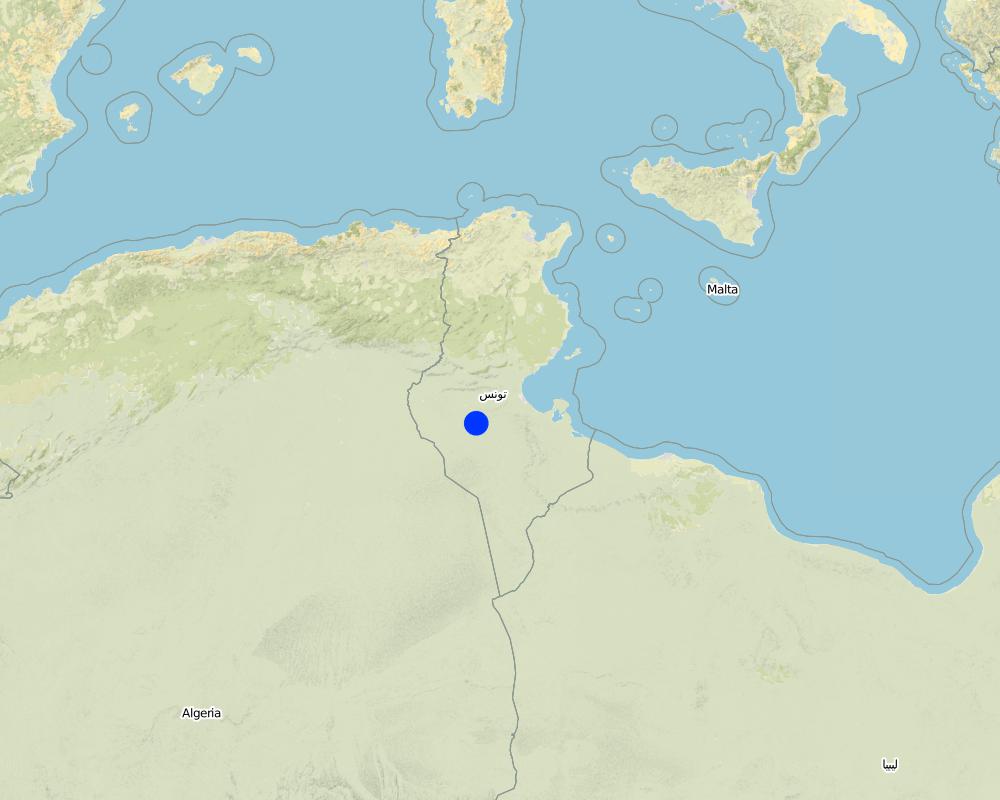Amendement sableux dans le système oasien [Tunisia]
- Creation:
- Update:
- Compiler: Donia Mühlematter
- Editors: saadallah jamila, nissaf karbout
- Reviewers: Donia Mühlematter, Alexandra Gavilano
Erradm
technologies_3732 - Tunisia
View sections
Expand all Collapse all1. General information
1.2 Contact details of resource persons and institutions involved in the assessment and documentation of the Technology
Key resource person(s)
land user:
Ben Abdelkader Mohamed
Tunisia
SLM specialist:
Saadallah Jamila
Commissariat Régional au Développement Agricole de Kebili
Tunisia
SLM specialist:
Karbout Nissaf
Institut des Régions Arides
Tunisia
Name of project which facilitated the documentation/ evaluation of the Technology (if relevant)
Decision Support for Mainstreaming and Scaling out Sustainable Land Management (GEF-FAO / DS-SLM)Name of the institution(s) which facilitated the documentation/ evaluation of the Technology (if relevant)
Commissariat Régional au Développement Agricole de Kebili (CRDA) - Tunisia1.3 Conditions regarding the use of data documented through WOCAT
The compiler and key resource person(s) accept the conditions regarding the use of data documented through WOCAT:
Yes
1.4 Declaration on sustainability of the described Technology
Is the Technology described here problematic with regard to land degradation, so that it cannot be declared a sustainable land management technology?
No
1.5 Reference to Questionnaire(s) on SLM Approaches (documented using WOCAT)
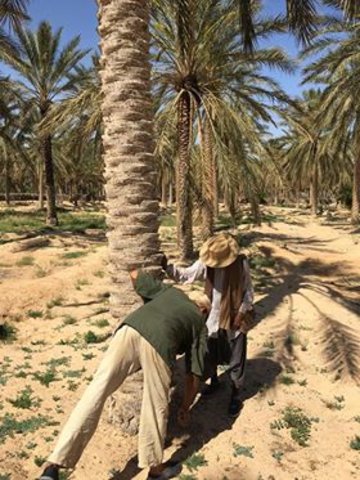
Initiative des agriculteurs pour l'application de l'amendement sableux … [Tunisia]
A cause de l’hydromorphie, l’agriculteur recourt à l’utilisation de l’amendement sableux pour proteger les terres agricoles dans les oasis.
- Compiler: Donia Mühlematter
2. Description of the SLM Technology
2.1 Short description of the Technology
Definition of the Technology:
Amendement sableux consiste à améliorer la fertilité de sol pour améliorer la production.
2.2 Detailed description of the Technology
Description:
Le dattier est une espèce termophile, son activité se manifeste à partir de 10°C, le dattier est cultivé comme arbre fruitier dans les régions arides et semi-arides chaudes, le dattier peut donc supporter des températures tres élevées. La fructification du dattier ne peut s'effectuer dans de bornes conditions que pendant l'époque de l'année la plus chaude pendant laquelle l'humidité relative de l'air est faible et la pluviométrie est nulle.
Le palmier résiste à l'eau chargée, en sel, qui est indispensable même à sa croissance. Les besoins en eau sont les plus élevés de toutes les fruitières 15000 à 2500 m3/an/ha. Pour D.N les besoins sont de 23.647 m3/ha/ an. 1 kg de dattes nécessite 1m3 d'eau. Il faut un débit moyen annuel continu de 0,5 à 0,6 l/s.
Le dattier est assez peu exigent sur la qualité du sol, bien que relativement résistante à l'asphyxie ses racines ne peuvent pas végéter dans l'eau stagnant, en effet dans les oasis le manque de drainage entraîne rapidement la salure du sol et la stérilité du terrain ceci est d'autant plus vrai qu'il s'agit de terre lourde. Dans le Djerid un réseau de drainage (à ciel ouvert) à 2,5 m de profondeur et distant de 150 à 200 m est suffisant pour assurer une bonne culture.
Le Dattier redoute les pluies et humidité atmosphérique pendant les périodes de pleine floraison et de développement du fruit, ces conditions constituent des limites à sa culture au même titre que le manque de chaleur estivale. Pendant la floraison une forte humidité favorise la pourriture des inflorescences et gène la germination des grains de pollen. Pendant la maturation elle diminue la transpiration des dattes, les fruits restent gorgés d'eau peuvent éclater. La pulpe en contact avec l'air va fermenter et pourrit.
Suite à la dégradation des oasis à cause de l’hydromorphie, salinité, remonté de la nappe.
La qualité primordiale du sol d'une palmeraie est la perméabilité, qu'elle soit irriguée ou alimentée directement par la nappe phréatique. Le choix du sol devra donc etre orienté vers les sols légers, les sables, sables limoneux, les limons sableux à faible teneur en argile (moins de 10 %). Les sols lourds, argileux, rocheux ou caillouteux sont à rejeter.
Lorsque la plantation ne dépend pas directement de la nappe phréatique, le sol doit avoir une profondeur minimale de 1,50 m à 2 m.
Pour cette raison, les agriculteurs ont créé la technique de l’amendement sableux, pour lutter contre les formes de dégradation de la fertilité du sol et la dégradation des palmiers dattiers.
La technique de l’amendement consiste à apporter le sable des dunes les plus proches pour créer un nouveau substrat pour le palmier dattier.
2.3 Photos of the Technology
2.5 Country/ region/ locations where the Technology has been applied and which are covered by this assessment
Country:
Tunisia
Region/ State/ Province:
Kébili
Specify the spread of the Technology:
- evenly spread over an area
If precise area is not known, indicate approximate area covered:
- < 0.1 km2 (10 ha)
Map
×2.6 Date of implementation
If precise year is not known, indicate approximate date:
- less than 10 years ago (recently)
2.7 Introduction of the Technology
Specify how the Technology was introduced:
- as part of a traditional system (> 50 years)
3. Classification of the SLM Technology
3.1 Main purpose(s) of the Technology
- improve production
- reduce, prevent, restore land degradation
- conserve ecosystem
- preserve/ improve biodiversity
- adapt to climate change/ extremes and its impacts
- mitigate climate change and its impacts
- create beneficial economic impact
- create beneficial social impact
3.2 Current land use type(s) where the Technology is applied
Land use mixed within the same land unit:
Yes
Specify mixed land use (crops/ grazing/ trees):
- Agroforestry

Cropland
- Perennial (non-woody) cropping
- Tree and shrub cropping
Tree and shrub cropping - Specify crops:
- dates
- fruits, other
- grapes
Number of growing seasons per year:
- 1

Grazing land
Extensive grazing:
- Ranching
Intensive grazing/ fodder production:
- Cut-and-carry/ zero grazing
Animal type:
- goats
- camels
- sheep
- Élevage ovin, camelin et caprin.
- Système oasien composé de 3 étages: - Palmier dattier. - Grenadier, vigne et pommier... - Cultures maraichères.
3.3 Has land use changed due to the implementation of the Technology?
Has land use changed due to the implementation of the Technology?
- Yes (Please fill out the questions below with regard to the land use before implementation of the Technology)
Comments:
Addition des cultures maraichage aprés l'introduction de la technologie de l'amendement sableux.
3.4 Water supply
Water supply for the land on which the Technology is applied:
- mixed rainfed-irrigated
3.5 SLM group to which the Technology belongs
- integrated soil fertility management
- improved plant varieties/ animal breeds
- irrigation management (incl. water supply, drainage)
3.6 SLM measures comprising the Technology

agronomic measures
- A1: Vegetation/ soil cover
- A2: Organic matter/ soil fertility
- A3: Soil surface treatment

vegetative measures
- V1: Tree and shrub cover
- V2: Grasses and perennial herbaceous plants
- V4: Replacement or removal of alien/ invasive species

structural measures
- S3: Graded ditches, channels, waterways
- S6: Walls, barriers, palisades, fences
- S7: Water harvesting/ supply/ irrigation equipment

management measures
- M1: Change of land use type
- M3: Layout according to natural and human environment
- M5: Control/ change of species composition
- M6: Waste management (recycling, re-use or reduce)
3.7 Main types of land degradation addressed by the Technology

soil erosion by water
- Wt: loss of topsoil/ surface erosion

soil erosion by wind
- Et: loss of topsoil

chemical soil deterioration
- Cn: fertility decline and reduced organic matter content (not caused by erosion)
- Cs: salinization/ alkalinization

physical soil deterioration
- Pi: soil sealing
- Pw: waterlogging

biological degradation
- Bc: reduction of vegetation cover
- Bh: loss of habitats
- Bq: quantity/ biomass decline
- Bs: quality and species composition/ diversity decline
- Bl: loss of soil life

water degradation
- Ha: aridification
3.8 Prevention, reduction, or restoration of land degradation
Specify the goal of the Technology with regard to land degradation:
- reduce land degradation
- restore/ rehabilitate severely degraded land
Comments:
L'amendement ne fait que lorsque les terres ont été déjà affecté par la dégradation.
4. Technical specifications, implementation activities, inputs, and costs
4.1 Technical drawing of the Technology
Technical specifications (related to technical drawing):
Densité des palmiers est 8 m * 8 m (C'est le meilleur espacement pour les palmiers dattiers).
L'apport des sables se fait par camion, pour amender 40 cm d'hauteur dans la première fois, puis aprés ça devient juste quelques centimètres juste pour entretenir le substrat du palmier et garder les racines couvertes.
Author:
Donia Jendoubi & Nissaf Karbout
Date:
2018
4.2 General information regarding the calculation of inputs and costs
Specify how costs and inputs were calculated:
- per Technology area
Indicate size and area unit:
ha
other/ national currency (specify):
Dinar Tunisien
If relevant, indicate exchange rate from USD to local currency (e.g. 1 USD = 79.9 Brazilian Real): 1 USD =:
2.45
Indicate average wage cost of hired labour per day:
20 - 25 TDN
4.3 Establishment activities
| Activity | Timing (season) | |
|---|---|---|
| 1. | Désherbage (supression des mauvaises herbes) | |
| 2. | Labour 30 - 40 cm | |
| 3. | Séchage du sol | |
| 4. | Apport des sables (40 cm) | |
| 5. | Épandage | |
| 6. | Labour pour malaxage | |
| 7. | Confection des cuvettes des palmiers | |
| 8. | Irrigation |
4.4 Costs and inputs needed for establishment
| Specify input | Unit | Quantity | Costs per Unit | Total costs per input | % of costs borne by land users | |
|---|---|---|---|---|---|---|
| Labour | Désherbage | personne/jour | 60.0 | 25.0 | 1500.0 | 1000.0 |
| Labour | Confection des cuvettes | personne/jour | 74.0 | 25.0 | 1850.0 | 100.0 |
| Equipment | Transport par camions | camion | 350.0 | 40.0 | 14000.0 | 100.0 |
| Equipment | Traction | heure | 80.0 | 20.0 | 1600.0 | 100.0 |
| Equipment | Épandage | heure | 80.0 | 20.0 | 1600.0 | 100.0 |
| Other | Eau (tour d'irrigation) | an | 1.0 | 600.0 | 600.0 | 100.0 |
| Total costs for establishment of the Technology | 21150.0 | |||||
| Total costs for establishment of the Technology in USD | 8632.65 | |||||
4.5 Maintenance/ recurrent activities
| Activity | Timing/ frequency | |
|---|---|---|
| 1. | Désherbage (supression des mauvaises herbes) | |
| 2. | Labour 30 - 40 cm | |
| 3. | Séchage du sol | |
| 4. | Apport des sables (moins que 40 cm) | |
| 5. | Épandage | |
| 6. | Labour pour malaxage | |
| 7. | Confection des cuvettes des palmiers | |
| 8. | Irrigation |
4.6 Costs and inputs needed for maintenance/ recurrent activities (per year)
| Specify input | Unit | Quantity | Costs per Unit | Total costs per input | % of costs borne by land users | |
|---|---|---|---|---|---|---|
| Labour | Désherbage | personne/jour | 60.0 | 25.0 | 1500.0 | 100.0 |
| Labour | Confection des cuvettes | personne/jour | 74.0 | 25.0 | 1850.0 | 100.0 |
| Equipment | Transport par camions | camion | 100.0 | 40.0 | 4000.0 | 100.0 |
| Equipment | Traction | heure | 80.0 | 20.0 | 1600.0 | 100.0 |
| Equipment | Épandage | heure | 25.0 | 20.0 | 500.0 | 100.0 |
| Other | Eau (Tour d'irrigation) | an | 1.0 | 600.0 | 600.0 | 100.0 |
| Total costs for maintenance of the Technology | 10050.0 | |||||
| Total costs for maintenance of the Technology in USD | 4102.04 | |||||
Comments:
L'entretien commence aprés 5 à 10 ans. Et ça dépend de la couche d'amendement.
4.7 Most important factors affecting the costs
Describe the most determinate factors affecting the costs:
Le cout d'apport est devenu plus cher (transport), ainsi que le cout de la main d'oeuvre.
5. Natural and human environment
5.1 Climate
Annual rainfall
- < 250 mm
- 251-500 mm
- 501-750 mm
- 751-1,000 mm
- 1,001-1,500 mm
- 1,501-2,000 mm
- 2,001-3,000 mm
- 3,001-4,000 mm
- > 4,000 mm
Specify average annual rainfall (if known), in mm:
90.00
Indicate the name of the reference meteorological station considered:
Centre de Kébili.
Agro-climatic zone
- arid
5.2 Topography
Slopes on average:
- flat (0-2%)
- gentle (3-5%)
- moderate (6-10%)
- rolling (11-15%)
- hilly (16-30%)
- steep (31-60%)
- very steep (>60%)
Landforms:
- plateau/plains
- ridges
- mountain slopes
- hill slopes
- footslopes
- valley floors
Altitudinal zone:
- 0-100 m a.s.l.
- 101-500 m a.s.l.
- 501-1,000 m a.s.l.
- 1,001-1,500 m a.s.l.
- 1,501-2,000 m a.s.l.
- 2,001-2,500 m a.s.l.
- 2,501-3,000 m a.s.l.
- 3,001-4,000 m a.s.l.
- > 4,000 m a.s.l.
Indicate if the Technology is specifically applied in:
- convex situations
Comments and further specifications on topography:
La région de Nefzawa est une toposéquence: le point le plus haut c'est l'oasis de Douz et la région la plus bas est l'oasis de Fatnassa.
5.3 Soils
Soil depth on average:
- very shallow (0-20 cm)
- shallow (21-50 cm)
- moderately deep (51-80 cm)
- deep (81-120 cm)
- very deep (> 120 cm)
Soil texture (topsoil):
- coarse/ light (sandy)
Soil texture (> 20 cm below surface):
- coarse/ light (sandy)
Topsoil organic matter:
- low (<1%)
If available, attach full soil description or specify the available information, e.g. soil type, soil PH/ acidity, Cation Exchange Capacity, nitrogen, salinity etc.
Encoutement gypseux au delà de 60 cm.
5.4 Water availability and quality
Ground water table:
> 50 m
Availability of surface water:
poor/ none
Water quality (untreated):
for agricultural use only (irrigation)
Is water salinity a problem?
Yes
Specify:
C'est le majeur problème.
Is flooding of the area occurring?
No
Comments and further specifications on water quality and quantity:
Pompage profond de la nappe continentale intercalaire, qui a une température supérieure à 60 °C.
5.5 Biodiversity
Species diversity:
- low
Habitat diversity:
- low
5.6 Characteristics of land users applying the Technology
Sedentary or nomadic:
- Sedentary
Market orientation of production system:
- mixed (subsistence/ commercial)
Off-farm income:
- 10-50% of all income
Relative level of wealth:
- average
Individuals or groups:
- individual/ household
Level of mechanization:
- mechanized/ motorized
Gender:
- men
Age of land users:
- middle-aged
Indicate other relevant characteristics of the land users:
L'exploitant de terre est un entrepreneur des batiments aussi.
5.7 Average area of land used by land users applying the Technology
- < 0.5 ha
- 0.5-1 ha
- 1-2 ha
- 2-5 ha
- 5-15 ha
- 15-50 ha
- 50-100 ha
- 100-500 ha
- 500-1,000 ha
- 1,000-10,000 ha
- > 10,000 ha
Is this considered small-, medium- or large-scale (referring to local context)?
- medium-scale
5.8 Land ownership, land use rights, and water use rights
Land ownership:
- individual, titled
Land use rights:
- individual
Water use rights:
- communal (organized)
5.9 Access to services and infrastructure
health:
- poor
- moderate
- good
education:
- poor
- moderate
- good
technical assistance:
- poor
- moderate
- good
employment (e.g. off-farm):
- poor
- moderate
- good
markets:
- poor
- moderate
- good
energy:
- poor
- moderate
- good
roads and transport:
- poor
- moderate
- good
drinking water and sanitation:
- poor
- moderate
- good
financial services:
- poor
- moderate
- good
6. Impacts and concluding statements
6.1 On-site impacts the Technology has shown
Socio-economic impacts
Production
crop production
crop quality
forest/ woodland quality
risk of production failure
product diversity
production area
land management
Income and costs
expenses on agricultural inputs
farm income
diversity of income sources
economic disparities
workload
Socio-cultural impacts
food security/ self-sufficiency
land use/ water rights
SLM/ land degradation knowledge
conflict mitigation
Comments/ specify:
À cause de nivellement par rapport aux parcelles voisins.
situation of socially and economically disadvantaged groups
Comments/ specify:
Les petits agriculteurs ne sont pas capables de faire l'amendement sableux.
Ecological impacts
Water cycle/ runoff
excess water drainage
evaporation
Soil
soil moisture
soil cover
soil loss
soil accumulation
soil crusting/ sealing
soil compaction
nutrient cycling/ recharge
salinity
soil organic matter/ below ground C
acidity
Biodiversity: vegetation, animals
Vegetation cover
biomass/ above ground C
plant diversity
habitat diversity
Climate and disaster risk reduction
drought impacts
impacts of cyclones, rain storms
emission of carbon and greenhouse gases
wind velocity
micro-climate
6.2 Off-site impacts the Technology has shown
damage on neighbours' fields
Comments/ specify:
Nivellement par rapport aux parcelles voisins.
damage on public/ private infrastructure
Comments/ specify:
Problème d'hydromorphie.
6.3 Exposure and sensitivity of the Technology to gradual climate change and climate-related extremes/ disasters (as perceived by land users)
Gradual climate change
Gradual climate change
| Season | increase or decrease | How does the Technology cope with it? | |
|---|---|---|---|
| annual temperature | increase | very well | |
| seasonal temperature | dry season | increase | very well |
| annual rainfall | decrease | well | |
| seasonal rainfall | wet/ rainy season | decrease | well |
Climate-related extremes (disasters)
Climatological disasters
| How does the Technology cope with it? | |
|---|---|
| drought | very well |
Biological disasters
| How does the Technology cope with it? | |
|---|---|
| epidemic diseases | very well |
Other climate-related consequences
Other climate-related consequences
| How does the Technology cope with it? | |
|---|---|
| reduced growing period | very well |
Comments:
L'amendement sableux a un effet positif et rapide sur la croissance de palmier dattier et sa vigueur.
6.4 Cost-benefit analysis
How do the benefits compare with the establishment costs (from land users’ perspective)?
Short-term returns:
negative
Long-term returns:
positive
How do the benefits compare with the maintenance/ recurrent costs (from land users' perspective)?
Short-term returns:
slightly negative
Long-term returns:
positive
6.5 Adoption of the Technology
- > 50%
Of all those who have adopted the Technology, how many did so spontaneously, i.e. without receiving any material incentives/ payments?
- 91-100%
Comments:
Selon les moyens financiers des agriculteurs.
6.6 Adaptation
Has the Technology been modified recently to adapt to changing conditions?
Yes
If yes, indicate to which changing conditions it was adapted:
- changing markets
Specify adaptation of the Technology (design, material/ species, etc.):
Il y a une grande demande pour appliquer l'amendement sableux parce que le valeur des dattes et trés haut et rentable.
6.7 Strengths/ advantages/ opportunities of the Technology
| Strengths/ advantages/ opportunities in the land user’s view |
|---|
| Production amélioré. |
| Fertilité du sol amélioré. |
| Amélioration de l'oasis (addition des cultures maraichères). |
| Protection des palmiers contre l'hydromorphie et la salinité du sol. |
| Strengths/ advantages/ opportunities in the compiler’s or other key resource person’s view |
|---|
| Amélioration de vigueur et production des palmiers. |
| Augmentation du tronc du palmier et augmentation des nombres des régines de 6 jusqu'à 8. |
| Réduction de l'hydromorphie et la salinité. |
| Stabiliser le pH dans le sol et amélioration des caractéristiques physico-chimique du sol. |
| Amélioration de qualité et quantité des dattes. |
6.8 Weaknesses/ disadvantages/ risks of the Technology and ways of overcoming them
| Weaknesses/ disadvantages/ risks in the land user’s view | How can they be overcome? |
|---|---|
| Beaucoup des dépenses. | Appui et subvention de la ministère d'agriculture (déjà en cours). |
| Manque d'encadrement et conseil. | Organiser des journées de formation et conseils. |
| Weaknesses/ disadvantages/ risks in the compiler’s or other key resource person’s view | How can they be overcome? |
|---|---|
| Apport de sable non controlé. | Régler et controler l'activité d'apport des sables. |
| Déséquilibre d'écosystème. | Aménagement des sites pour l'apport des sables qui doivent ètre gérés par des lois. |
| Méthodes non uniformes, anarchiques et traditionnelles (non étudié). | Harmonisation de la méthode par des bases scientifiques. |
| Pas de suivi et évaluation. | Appui, conseil et accompagnement de l'agriculteur et sa formation sur la production et la qualité du sol. |
7. References and links
7.1 Methods/ sources of information
- field visits, field surveys
2 agriculteurs.
- interviews with land users
2 agriculteurs.
- interviews with SLM specialists/ experts
8 spécialistes de CRDA de Kébili.
7.3 Links to relevant online information
Title/ description:
La filière des dattes communes dans les oasis de Gabès dans le contexte des aléas climatiques et économiques: fonctionnement, atouts et contraintes
URL:
https://www.memoireonline.com/02/12/5304/m_La-filiere-des-dattes-communes-dans-les-oasis-de-Gabes-dans-le-contexte-des-aleas-climatiques-et20.html
Title/ description:
Dans les oasis de Nafzoua
URL:
https://www.rcp-sirma.org/content/download/4236/31621/version/1/file/Exposition+Nefzaoua.pdf
Title/ description:
De l’identification des contraintes environnemental es à l’évaluation des performances agronomiques dans un système irrig ué collectif. Cas de l’oasis de Fatnassa (Nefzaoua, sud tunisien)
URL:
https://tel.archives-ouvertes.fr/tel-00473373/document
Links and modules
Expand all Collapse allLinks

Initiative des agriculteurs pour l'application de l'amendement sableux … [Tunisia]
A cause de l’hydromorphie, l’agriculteur recourt à l’utilisation de l’amendement sableux pour proteger les terres agricoles dans les oasis.
- Compiler: Donia Mühlematter
Modules
No modules


